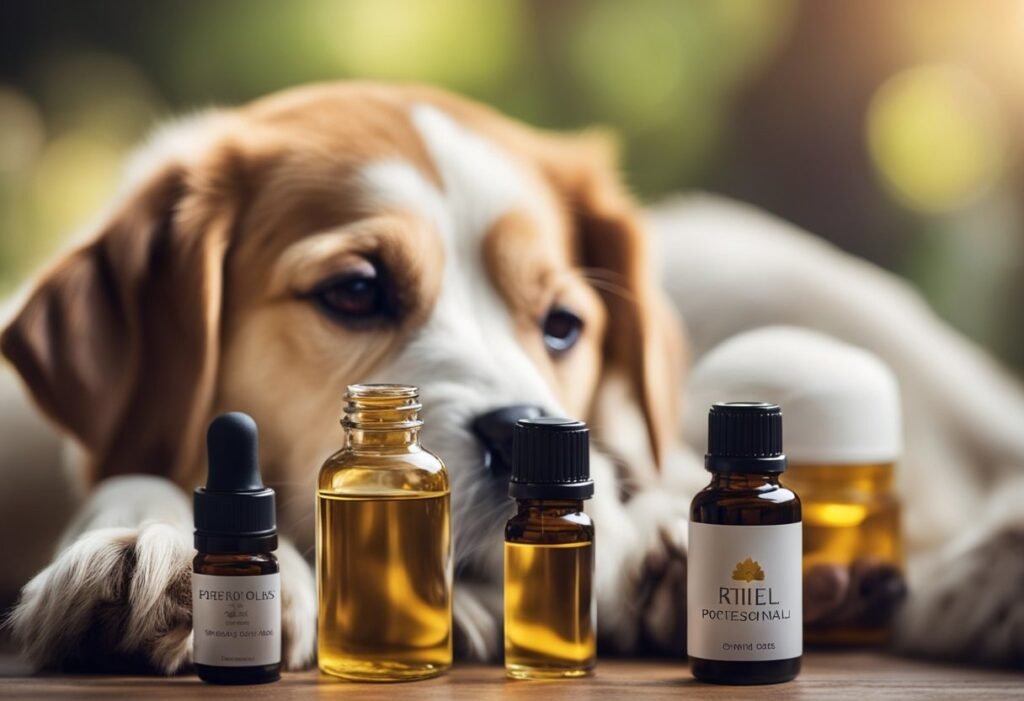Essential oils have become increasingly popular in recent years for their natural and holistic benefits. They are often used in aromatherapy, cleaning products, and even as a natural remedy for common ailments. But did you know that essential oils can also be used as a flea and tick repellent for your furry friend?
Many dog owners are turning to essential oils as a safer and more natural alternative to chemical-based flea and tick repellents. Not only are essential oils effective at repelling these pesky parasites, but they also have added benefits such as soothing skin irritations and promoting overall health and wellness for your dog. However, it’s important to note that not all essential oils are safe for dogs and proper dilution and application methods should always be followed.
In this article, we’ll explore the best essential oils for dog flea and tick repellent and how to safely use them on your furry friend. We’ll also provide tips on natural flea and tick prevention and how to create your own DIY essential oil flea and tick spray. With the right knowledge and precautions, essential oils can be a great addition to your dog’s natural health and wellness routine.
Understanding Fleas and Ticks

As dog owners, we know the importance of keeping our furry friends free from fleas and ticks. But what exactly are these pesky parasites, and why are they such a problem?
Fleas are small, wingless insects that feed on the blood of mammals and birds. They can cause a range of problems for dogs, including skin irritation, hair loss, and even anemia in severe cases. Ticks, on the other hand, are arachnids that attach themselves to the skin of their host and feed on their blood. They can transmit a variety of diseases, including Lyme disease, Rocky Mountain spotted fever, and Ehrlichiosis.
Fleas and ticks are most commonly found in warm, humid environments, such as wooded areas, grassy fields, and even our own backyards. They can also be brought into our homes by other pets or on our clothing.
Preventing flea and tick infestations is crucial for the health and well-being of our dogs. Regular grooming, including daily brushing and bathing, can help to remove any fleas or ticks that may be present on your dog’s coat. Additionally, there are a variety of flea and tick prevention products available, including spot-on treatments, collars, and oral medications.
Using essential oils as a natural flea and tick repellent can also be an effective option. However, it’s important to note that not all essential oils are safe for use on dogs, and some can be toxic. Always do your research and consult with your veterinarian before using any essential oils on your furry friend.
The Importance of Flea and Tick Prevention

As responsible pet owners, it is our duty to protect our furry friends from fleas and ticks. These tiny pests can cause a range of health problems for our dogs, from skin irritation to more serious diseases like Lyme disease and Rocky Mountain spotted fever.
Preventing flea and tick infestations is not only important for the health and wellbeing of our pets, but also for our own safety. Fleas and ticks can easily hitch a ride on our dogs and make their way into our homes, putting us at risk of bites and potential disease transmission.
Thankfully, there are many effective flea and tick prevention methods available, including the use of essential oils. These natural remedies can be a great alternative to chemical-based products, which can be harsh on our dogs’ skin and potentially harmful to their health.
By taking proactive measures to prevent flea and tick infestations, we can ensure that our dogs stay healthy and happy, and that we can enjoy their company without the worry of pests.
Essential Oils: An Overview
Essential oils are a popular alternative to chemical flea and tick repellents for dogs. They are natural plant extracts that are known for their aromatic and therapeutic properties. Essential oils are highly concentrated and can be used in small quantities to achieve their desired effect.
When it comes to flea and tick repellent, essential oils work by masking the scent of your dog, making it difficult for fleas and ticks to locate them. Some essential oils also have insecticidal properties that can help kill fleas and ticks on contact.
It’s important to note that not all essential oils are safe for dogs. Some essential oils can be toxic to dogs, so it’s essential to do your research before using any essential oils on your dog. Always dilute essential oils with a carrier oil before using them on your dog, and never apply them directly to your dog’s skin.
Some of the most popular essential oils for flea and tick repellent for dogs include:
- Lavender oil
- Lemongrass oil
- Cedarwood oil
- Peppermint oil
- Eucalyptus oil
- Citronella oil
Each of these oils has its unique properties and can be used in different ways to repel fleas and ticks. We will discuss each of these oils in more detail in the following sections.
How Essential Oils Work Against Fleas and Ticks

Essential oils are an effective natural remedy for flea and tick prevention in dogs. These oils work by repelling fleas and ticks with their strong scent and taste. When applied to your dog’s skin or fur, essential oils create a barrier that fleas and ticks find unappealing, making it less likely for them to attach to your dog.
Some essential oils, such as citronella, peppermint, and lemongrass, contain natural compounds that are toxic to fleas and ticks. These compounds are harmless to dogs but can be deadly to fleas and ticks. When applied to your dog’s skin or fur, these oils can kill fleas and ticks on contact, preventing infestations and reducing the risk of tick-borne diseases.
Essential oils can also be used to soothe and heal your dog’s skin after a flea or tick infestation. Oils such as lavender and tea tree have antibacterial and anti-inflammatory properties that can help reduce itching, redness, and inflammation caused by flea and tick bites.
It’s important to note that essential oils should be used with caution and under the guidance of a veterinarian. Some essential oils can be toxic to dogs if ingested or applied in large quantities. Always dilute essential oils with a carrier oil before applying them to your dog’s skin or fur, and avoid using them on puppies, pregnant dogs, or dogs with sensitive skin.
Safe Essential Oils for Dogs
When it comes to using essential oils as a natural flea and tick repellent for dogs, it’s important to choose oils that are safe for canine use. Here are some essential oils that are considered safe for dogs:
Lemongrass Oil
Lemongrass oil is a natural insecticide that can repel fleas, ticks, and other pests. It has a fresh, citrusy scent that dogs find pleasant. However, it’s important to dilute lemongrass oil before applying it to your dog’s skin, as it can cause skin irritation if used undiluted.
Cedarwood Oil
Cedarwood oil is another natural insecticide that can repel fleas and ticks. It has a woody, earthy scent that dogs find calming. Like lemongrass oil, cedarwood oil should be diluted before use.
Peppermint Oil
Peppermint oil has a refreshing scent that can repel fleas, ticks, and other pests. It also has a cooling effect that can soothe itchy skin. However, peppermint oil should be used with caution, as it can be irritating to some dogs.
Rosemary Oil
Rosemary oil is a natural flea repellent that can also help soothe irritated skin. It has a woody, herbal scent that dogs find pleasant. However, rosemary oil should be used in moderation, as it can be toxic in large amounts.
Lavender Oil
Lavender oil is a versatile essential oil that can repel fleas, ticks, and other pests. It also has a calming effect that can help reduce anxiety in dogs. However, lavender oil should be used in moderation, as it can be toxic in large amounts.
Overall, essential oils can be a safe and effective way to repel fleas and ticks on dogs. However, it’s important to use them with caution and always dilute them before use. If your dog shows any signs of irritation or discomfort after using essential oils, stop using them immediately and consult your veterinarian.
How to Apply Essential Oils
When it comes to applying essential oils for flea and tick repellent on dogs, there are a few things to keep in mind to ensure safety and effectiveness. Here are some tips on how to apply essential oils properly:
- Dilute the essential oil: Essential oils are highly concentrated and can be too strong for dogs if applied undiluted. Mix a few drops of the essential oil with a carrier oil such as coconut oil or olive oil before applying to your dog’s fur.
- Apply to the right areas: Apply the diluted essential oil to areas where fleas and ticks are likely to hide, such as the base of the tail, behind the ears, and under the legs. Avoid applying near the eyes, nose, or mouth.
- Use a spray bottle: A spray bottle can be a convenient way to apply essential oils to your dog’s fur. Mix the diluted essential oil with water in a spray bottle and mist your dog’s fur, being careful to avoid the face.
- Reapply as needed: Essential oils may need to be reapplied every few days to remain effective. Monitor your dog for any signs of irritation or discomfort and discontinue use if necessary.
Remember, essential oils should never be ingested by dogs and should always be used with caution. If you are unsure about using essential oils on your dog, consult with a veterinarian first.
Precautions When Using Essential Oils
When using essential oils as a dog flea and tick repellent, it is important to take necessary precautions to ensure the safety of your pet. Here are some precautions to keep in mind:
- Dilute the oils: Essential oils are highly concentrated and can be harmful to dogs if used undiluted. Always dilute the oils in a carrier oil such as coconut or olive oil before applying to your dog’s fur.
- Test for allergies: Before using any new essential oil, it is important to test for allergies. Apply a small amount of the diluted oil to your dog’s skin and monitor for any adverse reactions such as itching or redness.
- Avoid sensitive areas: Some essential oils can be irritating to sensitive areas such as the eyes, nose, and genitals. Avoid applying oils to these areas and be cautious when applying around the face.
- Keep oils out of reach: Essential oils should be kept out of reach of dogs and stored in a safe place. Ingesting essential oils can be toxic to dogs and cause serious health issues.
- Consult with a veterinarian: If you have any concerns or questions about using essential oils on your dog, it is always best to consult with a veterinarian. They can provide guidance on which oils are safe and how to properly use them.
By following these precautions, you can safely and effectively use essential oils as a natural flea and tick repellent for your furry friend.
Alternative Flea and Tick Prevention Methods
While essential oils can be an effective natural flea and tick repellent for dogs, they are not the only option. Here are some alternative prevention methods that can be used in conjunction with or instead of essential oils:
- Regular grooming: Brushing your dog’s coat regularly can help remove any fleas or ticks that may have attached themselves. It’s also a good opportunity to check for any signs of infestation or irritation.
- Flea combing: A flea comb is a specialized comb that can help remove fleas and their eggs from your dog’s coat. It’s important to comb slowly and carefully, paying special attention to the areas around the ears, tail, and belly.
- Diatomaceous earth: This natural substance can be sprinkled on your dog’s bedding or around the house to help kill fleas and ticks. It works by dehydrating the insects, causing them to die.
- Collars and spot-on treatments: There are a variety of flea and tick collars and spot-on treatments available on the market. It’s important to choose a product that is safe for your dog and follow the instructions carefully.
- Vacuuming: Regularly vacuuming your home can help remove any fleas or eggs that may be hiding in carpets or furniture. It’s also important to wash your dog’s bedding and any other fabric items they come into contact with.
By using a combination of these methods, you can help keep your dog flea and tick-free without relying solely on essential oils. As always, it’s important to consult with your veterinarian before starting any new flea and tick prevention regimen.
Conclusion

We hope that this article has provided you with valuable information on using essential oils as a natural flea and tick repellent for your furry friend. While essential oils can be a safe and effective alternative to chemical-based products, it is important to use them properly and with caution.
Remember to always dilute essential oils before use and avoid using them on pregnant or nursing dogs, puppies, or dogs with certain medical conditions. It is also important to consult with your veterinarian before using essential oils on your dog.
Some essential oils, such as tea tree oil, can be toxic to dogs if ingested in large amounts. Always keep essential oils stored in a safe place, out of reach of your dog.
In addition to using essential oils, it is important to maintain a clean and well-groomed environment for your dog. Regularly vacuuming and washing your dog’s bedding can help prevent flea and tick infestations.
Overall, incorporating essential oils into your dog’s flea and tick prevention routine can be a natural and effective way to keep your furry friend healthy and happy.
Frequently Asked Questions
What are some natural methods for repelling fleas and ticks on dogs?
There are several natural methods for repelling fleas and ticks on dogs. Some of the most effective methods include using essential oils, such as lavender, peppermint, and cedarwood, as well as using flea combs and regularly bathing your dog with a natural flea and tick shampoo.
What essential oils are safe to use on dogs for flea and tick prevention?
There are several essential oils that are safe to use on dogs for flea and tick prevention, including lavender, peppermint, cedarwood, and lemongrass. However, it is important to always dilute the essential oils and use them in moderation to avoid any potential adverse reactions.
Can essential oils be used as an effective alternative to traditional flea and tick prevention methods?
Yes, essential oils can be used as an effective alternative to traditional flea and tick prevention methods. However, it is important to note that essential oils may not be as effective as traditional methods and may require more frequent application.
What are the benefits of using natural flea and tick prevention methods?
Using natural flea and tick prevention methods can provide several benefits for both your dog and the environment. Natural methods are often less toxic and harmful than traditional methods, and can also be less expensive in the long run.
Are there any risks associated with using essential oils for flea and tick prevention on dogs?
Yes, there are some risks associated with using essential oils for flea and tick prevention on dogs. Essential oils can be toxic if ingested or if used in excessive amounts, and can also cause skin irritation or allergic reactions in some dogs.
Can homemade flea and tick sprays made with essential oils be effective for dogs?
Yes, homemade flea and tick sprays made with essential oils can be effective for dogs. However, it is important to always dilute the essential oils and use them in moderation to avoid any potential adverse reactions. It is also important to note that homemade sprays may not be as effective as commercial products and may require more frequent application.





